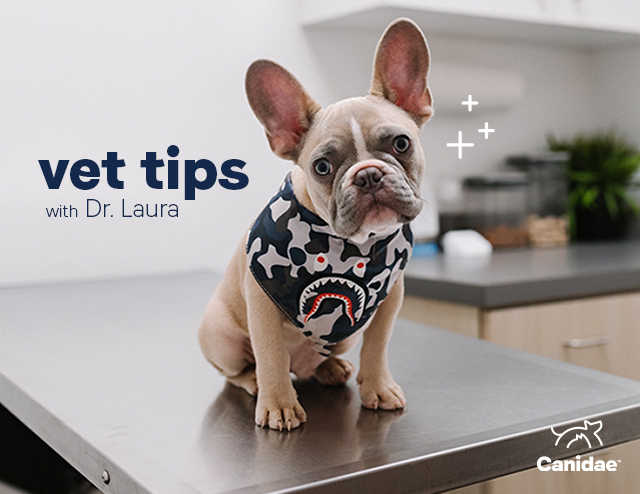New Puppy Check-list With Dr. Laura
Just expanded your family to include a new four-legged member? Congrats! It is important to get your puppy started off on the right foot soon after you get him/her. Dr. Laura Robinson, one of Canidae’s consulting veterinarians, shares her recommendations for what to focus on once you’ve brought your furry friend home (other than lots, and lots of snuggles).
The First Vet Visit
It is recommended to visit your veterinarian within the first week of getting your puppy. Your veterinarian can talk to you about things like diet, exercise and training recommendations. Puppies will need vaccines done every 3-4 weeks starting at age 6-8 weeks until they are 16 weeks old. In addition to vaccines, there are a few other veterinary recommendations for your puppy to make sure they get started on the right foot. Some of these recommendations might be:
- Stool sample sent out to check for internal parasites (i.e. tapeworm, roundworm, whipworm etc.)
- Deworming
- Microchipping
- Spaying and Neutering
- Bloodwork to ensure they are healthy
- Check for fleas and ear mites
- Heartworm and tick-borne disease testing
- Viral testing
- Flea and tick protection
While all these recommendations will vary a little bit from vet to vet and also on location, these are the most common things your veterinarian may recommend. It is a big responsibility to get a puppy, but also extremely exciting. You shouldn't wait to visit your veterinarian. Be sure to get started the right way and get all the advice you can!
Socialization
Socialization is extremely important for puppies
Socialization is getting puppies and kittens used to people, other animals, and experiences that they will encounter frequently in their adult lives. This will involve introducing them to as many new people, pets, places, things as possible while they are young. This period of their life will set them up for the rest of their lives and will teach them to react confidently and calmly to situations, people, and other animals instead of reacting fearfully or violently. I always recommend puppy training classes for socialization just as much as training.
It is okay to have vaccinated dogs visit your unvaccinated puppy as long as you stay in your home/yard. This is the only safe way to socialize as your pet shouldn’t go anywhere where other dogs have been until they are vaccinated.
Doggie daycare once they are vaccinated
When it makes sense
- If your dog has a lot of energy and/or likes to play then I would definitely recommend it. Young dogs especially like daycare because they are very playful and have a lot of energy. I also like daycare for adolescent dogs, high energy breeds (labs, jack russells, german shepherds, huskies etc), and working dogs (bordie collies, aussies, hunting dogs)
- It can be beneficial to young dogs because it also socializes them and they will be less likely to develop aggressive tendencies and will learn social cues from other dogs quicker, it also is a way to exercise them
- Dogs crave social interactions and thrive in the company of others (humans and/or other dogs)
- Can be helpful if your dog becomes destructive in the home or in the crate while you are away and you have tried other options without success
- Downsides to daycare: more likely to contract illnesses such as parasites or kennel cough as you don’t know if other dogs there are healthy, they are also more likely to injure themselves
- Typically not good for very anxious puppies, fearful adult dogs, dog reactive or aggressive dogs
How to evaluate
- Visit first!
- Should be clean, organized and look like a safe environment. If the visible things to the client are not clean and in good shape, then the non-visible areas are guaranteed to be even worse
- If there is an outdoor area, make sure the fencing is good
- Make sure there is nothing that looks like it could injure your dog
- I like daycares that separate large dogs from smaller dogs
- Talk to a few employees and ask them questions, see if you like them and their mission and if they seem like they care
Puppy food
When you bring a new puppy home, it is important to pick the right food. Your puppy should start off eating a recipe that is formulated specifically for puppies. Some great options include Canidae’s Sustain new salmon and barley puppy formula or Canidae Pure’s clean, premium recipes which include a grain-free and grain-inclusive options for puppies.
Puppy food is different from adult food. You want to pick food that has an AAFCO statement on it, meaning this food has been evaluated by AAFCO (Association of American Feed Control Officials). You can feed your new puppy just dry food, just wet food or a mixture of both, all are perfectly fine options. Typically you want to feed your new puppy 3-4x a day for the first 3-5 months so that their blood sugar doesn’t drop too much throughout the day. Puppies burn a lot of calories and require a lot of energy in their food. Puppy food typically is more calorie dense than adult food and contains higher fat, protein and calcium than adult food to ensure they have all the nutrients to grow appropriately. They also typically change the amino acid profile a bit to account for better growth and sometimes add DHA, a type of omega fatty acid found in their mother’s milk.
I usually recommend keeping them on puppy food until they are a year old, sometimes 1.5 years for giant breeds
Training
Training your puppy is definitely a worthwhile investment. Everything moving forward will be much easier on you and your puppy when they learn basic commands. I usually recommend getting started with puppy classes, which will help not only with training but also socialization. Working with a trainer is always a good idea. Many trainers will also come to your house as well. Positive reinforcement is usually the best, which entails giving a treat when a command is obeyed. I would start basic training right away with your puppy. I usually recommend crate training for puppies for potty training purposes.
How to crate train
- Put the crate in one of your dog's favorite areas of the home
- Feed their meals in the crate and give them treats in the crate so they learn to associate positive experiences with the crate
- Give them their favorite chew toy only when you put them in the crate so they again associate positive experiences with the crate. Make sure to use a safe toy that can be chewed on without you having to watch them for fear of ingestion.
- Use the crate and the crate only for nap time and bedtime.
- Do not use the crate for punishment i.e.placing them in there when they do something bad. You do not want any negative associations with the crate.
- Have a command you use to signal your dog to use the crate. Train them to associate this word with the crate such as "crate" or "kennel" and then place them in the crate and give them a treat.
- Start out with the above training and then leave the dog in there for small periods of time such as a few minutes then let them out and praise them. You can gradually increase the amount of time they spend in the crate over time.
- Be sure to not use the crate excessively. Your dog should not spend the majority of the day in the crate, they need mental and physical stimulation.
- Rule of thumb for how long they can hold their urine and how long they should stay in their crate is their age in months +1 so for instance a three month old puppy can hold their urine for 4 months (3+1)
- If your dog is having severe anxiety in the crate, talk to your veterinarian about what may be a better option for him/her.
Why crate training?
- It helps your dog learn the appropriate time and place to eliminate (urinate/defecate)
- It helps in making them feel safe once they get used to it
- Housetraining and destructive behavior are some of the top reasons dogs end up in shelters, by teaching appropriate training early, these bad habits can be prevented
- A dog's natural instinct is to find a quiet, calm area where they can find stillness and rest when they want to, a crate provides this
- Most dogs do not want to urinate or defecate where they sleep so the crate teaches them to hold it and helps tremendously with housetraining
- As mentioned above, it helps prevent destructive behavior like tearing up your shoes or getting into the trash or other things they shouldn't
Neutering / Spaying
- It is a choice, sometimes breeders will require you to spay/neuter or shelters will
- Is it vet recommended?
- Yes, most vets do recommend spaying and neutering for most dogs
- What are the benefits of neutering and spaying ? disadvantages?
- Benefits: usually better behaved, won’t get pregnant or try to escape your yard to mate, eliminate risks of certain cancers (ovarian, mammary, testicular, prostate), avoid emergencies like pyometra (infection of the uterus)
- Disadvantages: have some downsides in large breed dogs in regards to ligament/bone development, makes them slightly more prone to certain cancers such as HSA, sometimes causes weight gain
- Is it ever too late or too early?
- Never too late,, can be too early. In females, most vets recommend before the first or second heat cycle. In males, most vets recommend 5-8 months in small dogs and 8 months-2 years in large and breed dogs.
Vaccinations
Core vaccines
- DAPP combination vaccine
- Protects against Distemper virus, Adenovirus Type 1 and 2, Parvovirus, Parainfluenza Virus
- Recommended in all states
- Rabies vaccines
- Protects against Rabies virus
- Recommended in all states
- Some states it is required
Non-core vaccines
- Bordetella + Parainfluenza
- Both are respiratory diseases and involved in Kennel Cough
- Usually administered into the nostrils
- Recommended in most areas of the U.S.
- Leptospirosis
- This vaccines only protects against certain strains of Leptospirosis
- This disease is most common in the Midwest, Eastern and Southwestern USA and is usually transmitted by wildlife
- Lyme disease
- Spread by ticks so most common in high tick areas such as Northeast, Upper Midwest and West Coast
- Recommend to have your dog on a tick preventative to also help limit tick bites and transmission
- Canine Influenza
- Most commonly transmitted in areas where dogs are in close contact such as kennels, groomers, day care, shelters etc
- Vaccines can help offer protection but do not 100% eliminate the chances of contracting influenza.
- Newer disease and not too prevalent yet but has been seen in most states
- Rattlesnake vaccine
- Should only be given to dogs in high risk areas where rattlesnakes are known to live
- Does not protect your dog from the venom but allows for a better chance of survival if bitten
- Are there any particular vaccines that can come up - special situations?
- Coronavirus, Lepto, Lyme, Rattlesnake
- How quickly should you vaccinate your kitten/puppy
- Vaccines start between 6-8 wks old and go until they’re 16 wks old
- Cost of vaccinations?
- Usually between $10-25 per vaccine
The list may seem long - a new puppy is lots of responsibility after all - but luckily it’s also sprinkled with love, licks, laughs and walks.
Subscribe to Canidae’s blog and follow @canidaepetfood and @vet.lo.robinson for more tips and tricks on how to keep your dog healthy and happy throughout its life.



